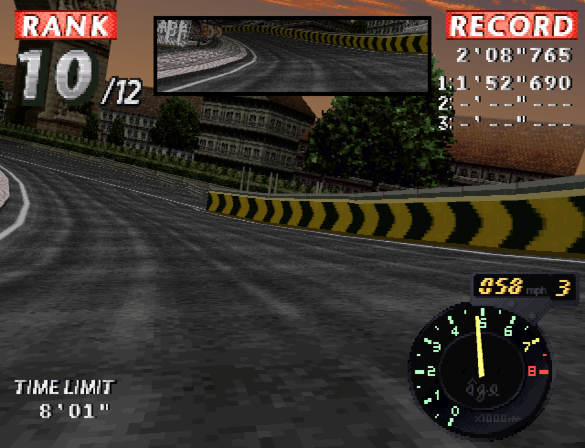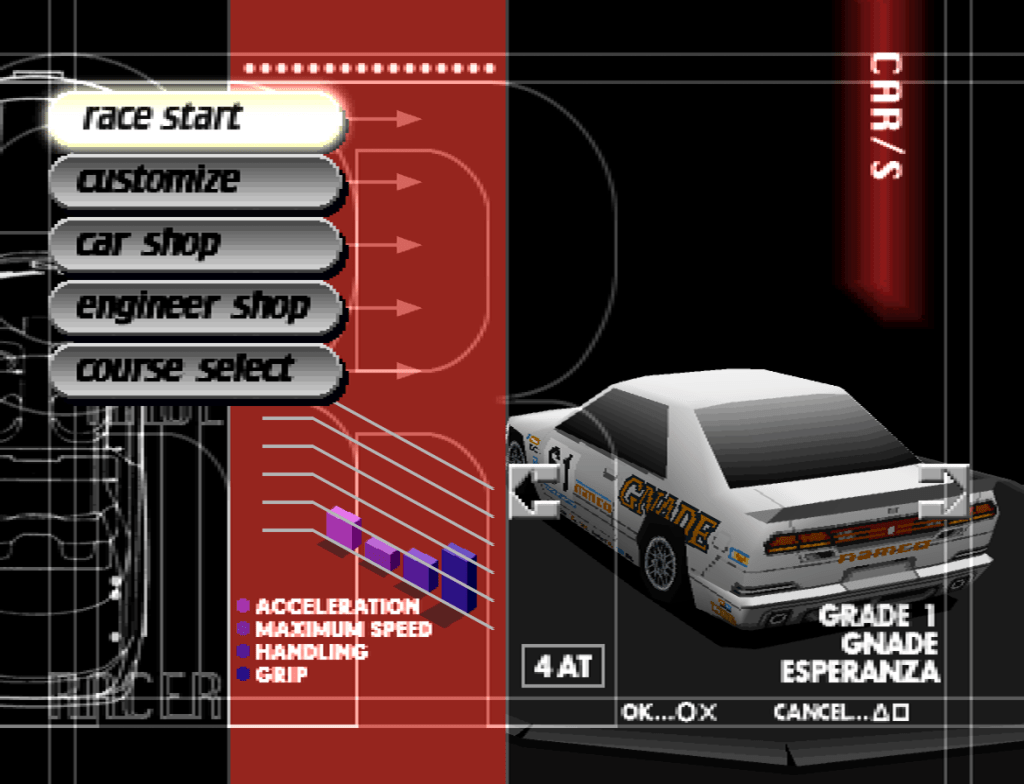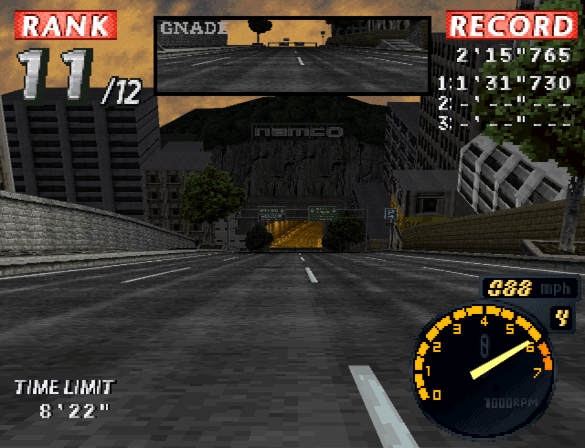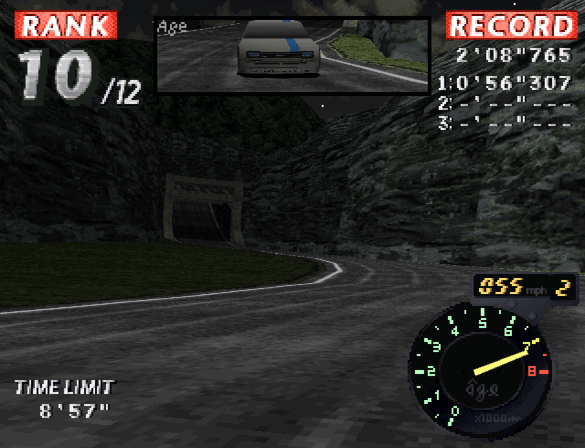The third console instalment of the Ridge Racer series. This sets on a more darker tone, with more realistic looking graphics and a completely revised soundtrack inspired by industrial drum and bass.

Grand Prix
The main game mode where you complete a series of races. Like the previous game you start in bottom place and have to finish in third place or higher against the computer controlled cars. There are five classes in total with a bonus sixth class and an extra GP, which is unlocked by completing the main GP mode.

Medals are awarded depending on what place you finish in. As you play the game you will need to replay a few of the races to build up your credit in order to purchase new vehicles, as you move up the GP class the competitors cars also get faster
Unlike the previous games in the Ridge Racer series, cars are handled differently with you only starting from one car, instead of four being available. When more races are completed, credit are awarded which allow you to spend them on buying new cars or upgrading your existing car, which will be required in order for you to progress though the next class of GP. Different cars have different specifications, with some having better handling, acceleration or top speed. Some of the later cars are in manual transmission only which requires you to manually change and shift gears.
The Grand Prix mechanic would be expanded heavily in it’s successor – Ridge Racer Type 4.

Time Attack
The mode that no one ever uses, here you get access to the fastest models of the cards with the goal of having the fastest time.
Tracks
Like the previous Ridge Racer PlayStation games, they all use the same track with some variations in them, Rage Racer is no exception as all tracks have the same starting area but then branch off into different sections and bends, which then combine back together at the end of the lap. This gives the premise of the tracks being set in the same urban city or a town.

The tracks follow a specific design and were designed around the PlayStation’s limitations, as most tracks feature bends that obscure the environmental view as to prevent pop in and to keep the game running at 30fps. Slope and hills are also used to this effect and are incorporated as a game mechanic as for manual transmission vehicles you have to drop down a gear in order to maintain your speed. All of this was used in the next Ridge Racer Game (Type 4) to greater effect and shows how Namco was able to make the most out of the PlayStation hardware which was becoming mainstream at this point.

The environments themselves feature a European look judging from the building design, and some Greek style columns can be seen with the first track, which contrasts from the Japanese look of the city in the first game.
However the quantity of the tracks is part of the games downfall, with it recycling the same tracks as reversed and mirrored. It would have been nice to race on the original tracks from Ridge Racer and Revolution, or include the Rave Racer tracks which was already released to the arcades by the time Rave Racer came out. The fact that most tracks are reused limits the variety and questions the value of the game, eventually you are going to get bored of these tracks. It’s even worse when you compare it to the Rush and Crusin series of game which feature way more tracks that are independent from each other.

Mystical Coast: The started course for the game, driving past the waterfall into the tunnel, then pass down onto the coast area with Spanish/meddidertain style housing and then into some ruins until you reach a tunnel that takes you back to the starting line
Over Pass City: starts the name as Mystical Coast where you pass the waterfall but the tunnel takes a different direction into the main city, here there are very steep hills past the tram and steep curves as you return to the starting line. This is the longest course in the game.
Lakeside Gate: Tricky since there are a lot of sharp turns where you need to drift sharply. Reaching top speed isn’t much of an issue here but having a car that you can control well is necessary. There’s a lot of tunnels and cave/hill like scenery when then proceeds into a rural area with some open scenery.
The Extreme Oval: A simple track designed for cars to reach their top speeds, but has one sharp turn within a tunnel.

Music
As someone who regularly listens to drum and bass, the music in Rage Racer was a pleasure to listen to with many songs taking inspiration from the industrial rock and break beat samples of the era. With many tracks being inspired by popular tracks of the era. They are also similar to music that was used in Namco’s other games, like in Tekken.

Conclusion
As a Ridge Racer game it takes the series into a more serious setting with its GP/credit based mechanic and its realistic art style but as a racing game it falls short due to lack of content, especially with the amount of tracks.

The game as not been released on any digital platforms, which is odd since this is an entirely Namco game that does not feature any licensed cards or music.
Pingback: Ridge Racer V | Drew1440: Blog